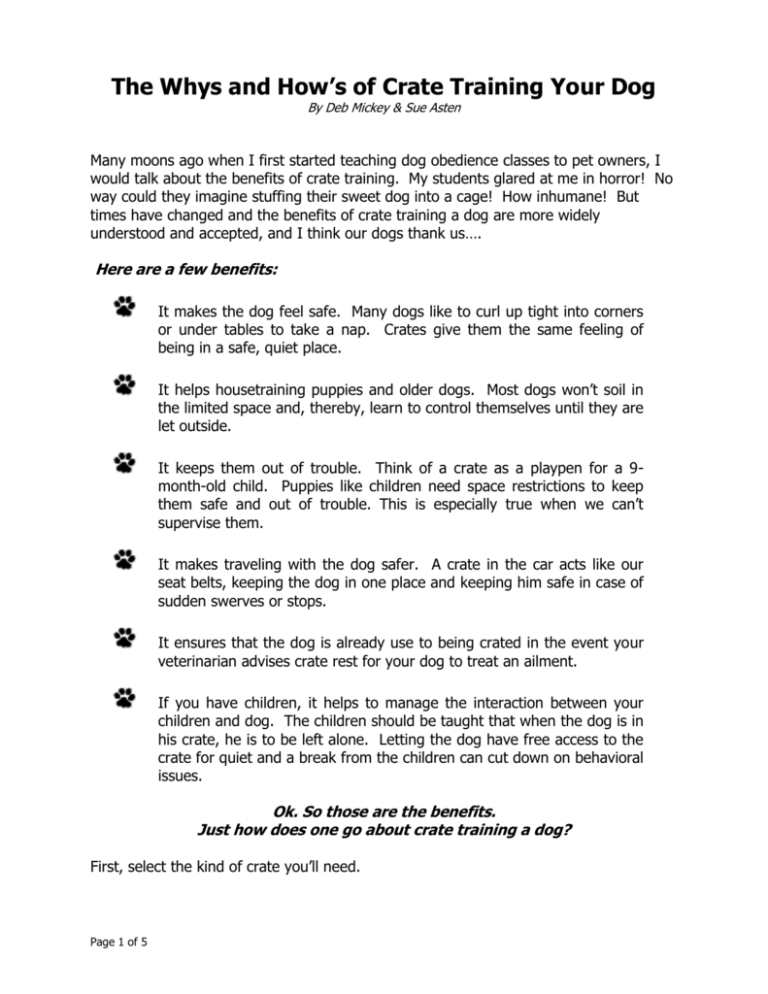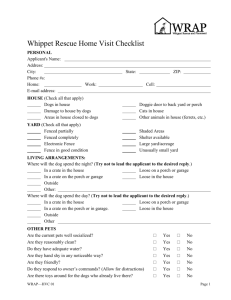The Whys and How`s of Crate Training Your Dog
advertisement

The Whys and How’s of Crate Training Your Dog By Deb Mickey & Sue Asten Many moons ago when I first started teaching dog obedience classes to pet owners, I would talk about the benefits of crate training. My students glared at me in horror! No way could they imagine stuffing their sweet dog into a cage! How inhumane! But times have changed and the benefits of crate training a dog are more widely understood and accepted, and I think our dogs thank us…. Here are a few benefits: It makes the dog feel safe. Many dogs like to curl up tight into corners or under tables to take a nap. Crates give them the same feeling of being in a safe, quiet place. It helps housetraining puppies and older dogs. Most dogs won’t soil in the limited space and, thereby, learn to control themselves until they are let outside. It keeps them out of trouble. Think of a crate as a playpen for a 9month-old child. Puppies like children need space restrictions to keep them safe and out of trouble. This is especially true when we can’t supervise them. It makes traveling with the dog safer. A crate in the car acts like our seat belts, keeping the dog in one place and keeping him safe in case of sudden swerves or stops. It ensures that the dog is already use to being crated in the event your veterinarian advises crate rest for your dog to treat an ailment. If you have children, it helps to manage the interaction between your children and dog. The children should be taught that when the dog is in his crate, he is to be left alone. Letting the dog have free access to the crate for quiet and a break from the children can cut down on behavioral issues. Ok. So those are the benefits. Just how does one go about crate training a dog? First, select the kind of crate you’ll need. Page 1 of 5 Finding the Right Crate There are many styles, but they all fall into 3 major categories: the wire-crate; the plastic, solid-sided crate; and the nylon mesh crate. Many of the wire crates and the nylon mesh crates fold down for easy moving and the plastic-sided crates can be taken apart. The nylon mesh crates are good for dogs that are already crated trained and are good for travel, but are easily chewed and damaged by untrained dogs. For the initial period of crate training, it’s recommended that a wire or plastic-side crate be used. Sample Crates Wire Crate Plastic-Sided Crates Nylon Mesh Crates Second, pick the size crate that will fit your dog when he is an adult. As an adult, he should be able to stand up, turn around, and lie down in the crate. Now comes the training part. First and foremost, keep in mind that as with any training, crate training must be done in a positive, upbeat way. The dog should always associate the crate with pleasant experiences and think of the crate as a pleasant place to be. The crate should never be used as punishment. Be patient and persistent. This training may take some time. Introduce Your Dog to the Crate Place the crate in a part of your home that has the most traffic such as your TV room. Place some soft blankets* in the crate. Make sure the door is propped open so it won’t swing or bang into the dog and scare him. Encourage your dog to come to the crate using a happy, playful voice. Toss a few dog treats by the crate, then at the door of the crate, and finally in the crate to encourage your dog to enter. If your dog prefers Page 2 of 5 toys to food, play with your dog with his favorite toy outside the crate, eventually tossing the toy into the crate for him to bring back out to you. Don’t worry if he doesn’t go in right away or doesn’t go in all the way. Praise him for being interested in the crate. Continue with this until he’s readily going in and out of the crate. Be patient! All dogs are different and learn at different speeds. Some dogs may be comfortable hopping in and out in the first session. Others may need several sessions of playing/tossing treats by and in the crate before they are willing to go all the way in. *If your dog doesn’t like the feel of the blankets slipping around under his feet, use something that has rubber backing on it, such as a bathroom mat, or a piece of rubber backed carpet. The Next Step … Next, begin to feed your dog his regular meals in the crate. If he’s a little resistant, place the food bowl just inside the door and, as he becomes more comfortable, with each successive meal, gradually move the bowl further and further back into the crate. When he’s readily going to the back of the crate for his meal, you’re ready for the next step. The Next Step … While your dog is calmly eating his meal in the back of the crate, quietly close the crate door. In the beginning, sit by the crate and immediately open the door when he’s finished eating. A few meals later close the door and stay in the room but leave the door closed after he finishes eating for a short period of time. Then, with each successive meal, keep the door shut for longer periods of time until he can be left in the crate 10-15 minutes after he finishes eating. If he whines, you may have increased the time too quickly. Next time leave him in a shorter time. (See tips on whining below) Now it’s time to increase the crate time… Once your dog is eating his meals in his crate and can stay in the crate with the door closed without showing anxiety or worry, you’re ready to move on. Now toss a treat into the crate while you say a command or signal word such as “get in” or “kennel.” Always use this word as a signal to your dog that it’s time to get in the crate. When the dog gets in the crate, praise him and shut the door. Sit quietly close by the crate for 10-15 minutes, then calmly and quietly go to another room for a few minutes. Return and sit quietly beside the crate again a few minutes, then quietly let the dog out of the crate. Page 3 of 5 Repeat this frequently during the day, each time lengthening the time the dog is in the crate and you are out of the room. Once your dog can quietly stay in his crate 40 minutes while you are out of the room, he’s ready to be crated while you leave the house to run quick errands or overnight while he sleeps. If he’s to sleep in his crate overnight, you might want to move the crate into your bedroom. Crating the Dog While You’re Gone When your dog can stay in his crate without being anxious or frightened while you’re out of the room for 40 or 60 minutes, he’s ready for you to leave the house. Use your treat and signal word to get him in the crate, praise him, and quietly leave. Make your departures and your arrivals matter-of-fact, resisting fussing over the dog. The more low-keyed you are about your coming and going, the more relaxed and less anxious your dog will be. The first time you leave the house, make it brief, no more than a half hour to an hour. If your dog appears to be calm and not agitated when you return, you’re ready to move on to longer periods of leaving your dog crated alone in the house. A Tip – to keep your dog occupied while you’re gone, place safe toys, such as a Kong toy filled with peanut butter in the crate with your dog. Licking the peanut butter out of the Kong will keep him busy! You can also turn on a radio at a low volume to easy listening music. Music is a soothing aid that may help keep the dog relaxed while you're gone. The Standard Kong Toy Page 4 of 5 The Kong Treat Ball Some Problems When Crating Being crated too long. If the dog is crated too long, such as crated all day while you’re at work then again at night while you sleep, the dog might become to feel trapped and frustrated. Dogs, especially young dogs, need a lot of interaction and physical exercise. Young puppies should not be crated longer than 3 to 4 hours at a stretch, as they cannot control their bladders for longer periods of time. The timeframe for crating older dogs varies by dog. Many dogs can be crated 8 hours as long as they have ample exercise and interaction with you in the morning and evening when you are home. Isolation. The crate should not be used to isolate the dog from the family. Dogs are very social creatures and need companionship, just as we do. Leaving a dog in a crate in the basement or in a garage is in some ways worse than leaving the dog tied to a chain in the back yard. Being separated from the family for too long can lead to serious behavioral issues with the dog. Place the crate in its permanent spot somewhere where you spend a lot of time, such as in your bedroom. Whining. It’s hard to tell when a dog whines in the crate whether he needs to go outside to relieve himself, or if he’s being crated for too long, or if he’s not having enough exercise or interaction with you, or if he’s just whining to manipulate you to open the door and let him out. If he whines, it’s very important that you do not open the door until he stops whining. If you open the door when he’s whining, he learns that whining gets him out. This escalates the whining, which can become very annoying. Wait until he stops whining, count to 5 and, if the dog has remained quiet, calmly open the door. He won’t get in the crate. If your dog hesitates or appears afraid to get in the crate, you’ve moved your training along too quickly. Go back to the beginning steps and make it fun for the dog. Or, if your dog is crated trained and doesn’t want to get in the crate, he may be spending too much time in the crate. All dogs are different and learn at a different pace*. However, if you follow the above procedures with your dog, and remember to have patience and take your time, you should end up with a dog that eagerly gets in his crate and is happy and well adjusted, and you’ll have the crate tool to use whenever necessary. *Special note - if after following all the steps your dog is still too upset at being crated, don’t force the issue! You may have to find an alternative method of safely leaving your dog alone, such as gating them in a small room in the house. Contact the Fieldwood Dog Training Center for additional assistance when crate training your dog. Page 5 of 5









